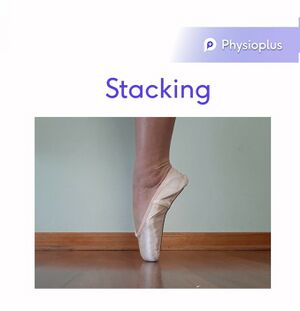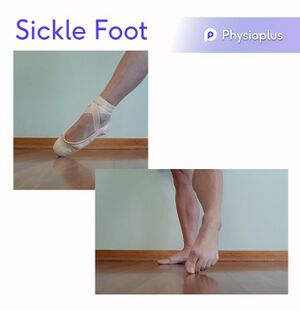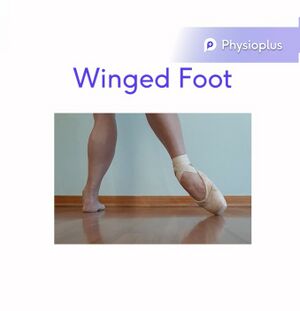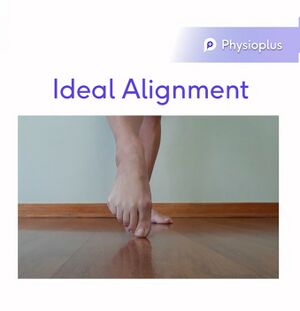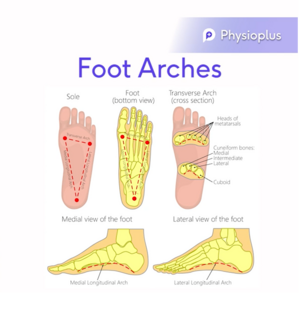Biomechanics of the Dancer’s Ankle and Foot: Difference between revisions
No edit summary |
No edit summary |
||
| Line 86: | Line 86: | ||
== Three Key Elements in a "Good" Ballet Foot == | == Three Key Elements in a "Good" Ballet Foot == | ||
=== 1. Arches === | === 1. Arches === | ||
There are | There are three arches in the foot:<ref name=":2" /> | ||
# Medial longitudinal | # Medial longitudinal | ||
## | ## Designed to allow the foot to trespass uneven surfaces and absorb shock | ||
# Lateral longitudinal | # Lateral longitudinal | ||
## | ## Stability | ||
# Anterior transverse | # Anterior transverse | ||
## | ## Aids in support and shock absorption, stability and balance, especially in relevé | ||
[[File:Foot Arches.png|center|frameless]] | [[File:Foot Arches.png|center|frameless]] | ||
These arches contribute to normal weight distribution, stability and distribution in dancing. The arches are formed by the tarsal and metatarsal bones. The shape allows them to act as a spring, bearing the weight of the body and absorbing the shock produced during dancing | These arches contribute to normal weight distribution, stability and distribution in dancing. The arches are formed by the tarsal and metatarsal bones. The shape allows them to act as a spring, bearing the weight of the body and absorbing the shock produced during dancing | ||
The height of the arches is determined by the bone structure and influenced by muscles and the flexibility of ligaments. | The height of the arches is determined by the bone structure and influenced by muscles and the flexibility of ligaments. Arches in dancers' feet are commonly described as: | ||
# High | # High | ||
| Line 103: | Line 103: | ||
# Flat | # Flat | ||
A medium arch is considered ideal. It allows good shock absorption | A medium arch is considered ideal. It allows good shock absorption, as well as flexibility as the ligaments are not so tight that they will restrict movement.<ref name=":2" /> | ||
==== The | ==== The Importance of Arches in Ballet ==== | ||
As mentioned above, the arches of the foot are important for optimal function, but for a ballet dancer, there are interesting complications to irregular arches. | As mentioned above, the arches of the foot are important for optimal function, but for a ballet dancer, there are interesting complications to irregular arches.<ref name=":2" /> | ||
* Weak lateral longitudinal arch | * Weak lateral longitudinal arch | ||
| Line 116: | Line 116: | ||
=== 2. Intrinsic Foot Muscles === | === 2. Intrinsic Foot Muscles === | ||
The | The most important role of the intrinsic foot muscles for ballet dancers is to oppose the clawing effect of the long flexors of the toes. When the toes are flexed at the metatarsal phalangeal joints, the action of the intrinsic muscles helps to keep the interphalangeal joints straight.<ref name=":2" /> | ||
=== 3. Plantar Fascia === | === 3. Plantar Fascia === | ||
Another key structure is the plantar fascia | Another key structure is the [[Plantar Aponeurosis|plantar fascia]]. The plantar fascia is a band of connective tissue that runs along the plantar or bottom surface of the foot. It acts as the main support for the medial longitudinal arch and, therefore, plays a key role in stabilising the foot in actions that require someone to push off the ground for propulsion (e.g. jumping or running). | ||
== Turnout == | == Turnout == | ||
For a dancer to have good turnout, they need range and strength further up the chain. When this is not the case | For a dancer to have good turnout, they need range and strength further up the chain. When this is not the case (e.g. a dancer does not have sufficient external rotation in the hips<ref>Kaufmann JE, Nelissen RG, Exner-Grave E, Gademan MG. [https://www.sciencedirect.com/science/article/pii/S002192902030508X Does forced or compensated turnout lead to musculoskeletal injuries in dancers? A systematic review on the complexity of causes.] Journal of Biomechanics. 2021 Jan 4;114:110084.</ref> to enable correct turnout), we usually find THREE compensations:<ref name=":0" /> | ||
# Lower back | # Lower back | ||
## A | ## A sway back posture, or lumbar hyperlordosis, combined with slightly flexed knees can cause an anterior pelvic tilt, greater hip flexion and the relaxation of the anterior capsule of the hip. | ||
# Knees | # Knees | ||
## A slightly flexed knee can allow increased external rotation of the lower limbs. This also increases the amount of grip | ## A slightly flexed knee can allow increased external rotation of the lower limbs. This also increases the amount of grip required by the toes to maintain the position.<ref>Carter SL, Duncan R, Weidemann AL, Hopper LS. [https://www.tandfonline.com/doi/abs/10.1080/02640414.2018.1446386 Lower leg and foot contributions to turnout in female pre-professional dancers: a 3D kinematic analysis]. Journal of Sports Sciences. 2018 Oct 2;36(19):2217-25.</ref> | ||
# Feet | # Feet | ||
## Hyperpronation, as described below, can appear to increase turnout | ## Hyperpronation, as described below, can appear to increase turnout because of the abduction of the forefoot. This compensation causes increased tension in the lower back, knee and medial aspect of the foot.<ref>Rietveld AB. [https://link.springer.com/article/10.1007/s10067-013-2184-8 Dancers’ and musicians’ injuries]. Clinical rheumatology. 2013 Apr;32(4):425-34.</ref> | ||
== Hyperpronation == | == Hyperpronation == | ||
Hyperpronation | Hyperpronation (i.e. excessive pronation of the ankle joint), often causes strain on the supporting structures, such as ligaments and tendons, on both the medial and the plantar aspects of the foot. This can lead to: | ||
* Medial tibial stress syndrome | * [[Shin-splints|Medial tibial stress syndrome]] | ||
* Flexor hallucis longus tendonitis | * [[Dancer's Tendonitis|Flexor hallucis longus tendonitis]] | ||
* [[Plantar Fasciitis|Plantar fasciitis]] | * [[Plantar Fasciitis|Plantar fasciitis]] | ||
* [[Patellofemoral Pain Syndrome|Patellofemoral pain syndrome]] | * [[Patellofemoral Pain Syndrome|Patellofemoral pain syndrome]] | ||
* Retropatellar chondropathy | * [[Chondromalacia Patellae|Retropatellar chondropathy]] | ||
* [[Low Back Pain|Lower back pain]] | * [[Low Back Pain|Lower back pain]] | ||
According to an article written by Nowacki et al<ref>Nowacki RM, Air ME, Rietveld AB. [https://www.ingentaconnect.com/content/jmrp/jdms/2012/00000016/00000003/art00006 Hyperpronation in dancers incidence and relation to calcaneal angle]. Journal of Dance Medicine & Science. 2012 Sep 15;16(3):126-32.</ref> | According to an article written by Nowacki et al.,<ref>Nowacki RM, Air ME, Rietveld AB. [https://www.ingentaconnect.com/content/jmrp/jdms/2012/00000016/00000003/art00006 Hyperpronation in dancers incidence and relation to calcaneal angle]. Journal of Dance Medicine & Science. 2012 Sep 15;16(3):126-32.</ref> hyperpronation has also been found to contribute to the following conditions: | ||
* Non-contact anterior cruciate ligament (ACL) injuries | * Non-contact [[Anterior Cruciate Ligament (ACL) Injury|anterior cruciate ligament (ACL) injuries]] | ||
* Sesamoiditis | * [[Sesamoiditis]] | ||
* Achilles tendonitis | * [[Achilles Tendinopathy|Achilles tendonitis]] | ||
* Leg length discrepancies | * [[Leg Length Discrepancy|Leg length discrepancies]] | ||
* Stress fractures | * [[Stress Fractures|Stress fractures]] | ||
* Hallux valgus | * [[Hallux Valgus|Hallux valgus]] | ||
* Bunions | * Bunions | ||
Revision as of 02:15, 16 May 2022
Top Contributors - Carin Hunter, Jess Bell and Kim Jackson
Introduction[edit | edit source]
Assessing an injury in a ballet patient can be a daunting task. After gaining a basic understanding of the foot and ankle anatomy, applying biomechanical principles can help the therapist form a clear picture of the treatment plan. Dancers spend the majority of their time in extreme positions, especially plantarflexion and dorsiflexion of their ankle. If professionals (dancers and therapists) do not understand the requirements for these positions and the demands incurred, compensation can occur further up the kinetic chain, resulting in pain and injury.
The “Ideal” Anatomy for a Ballet Foot[edit | edit source]
While there is no "ideal" ballet foot, the following features could be considered optimal:[1]
- Maximal plantarflexion in the talocrural joint[2]
- Maximal dorsiflexion in the first metatarsophalangeal joint
- A medium arch
- A square foot where the first and second rays are of equal length could be considered the "best" foot shape for dancers
- Straight toes
- Strong intrinsic and extrinsic muscles
- Maximum flexibility, control, strength and endurance[3]
- Ideally, a genetic aspect of some form of hypermobility
The "Ideal" Biomechanics for a Ballet Foot[edit | edit source]
- Ideal turnout,[4] as a result of strong external hip rotators
- Strong flexible back
- Control and coordination of hypermobility
- Active stabilisation of the trunk
- Excellent ballet technique
Movements of the Foot and Ankle[edit | edit source]
Ankle[edit | edit source]
Foot (excluding toes)[edit | edit source]
- Inversion[1]
- Excess inversion results in sickle foot (see image)
- Eversion[1]
- Excess eversion results in winged foot (see image)
Toes[edit | edit source]
- Dorsiflexion
- Plantarflexion
- Abduction
- Often accompanies dorsiflexion
- Adduction
- Often accompanies plantarflexion
The combination of movements across subtalar and tibiotalar joints causes supination and pronation.[1]
Ankle ROM[edit | edit source]
Having sufficient range of motion (ROM) in the ankle joint is vital for the ballet dancer. Inadequate ROM can cause pain, compensation and injury.[1]
Average ROM[edit | edit source]
The expected plantarflexion range of motion in an average human is 30-50 degrees, while the expected dorsiflexion range of motion with the knee extended is 10 degrees. When the knee is flexed, the expected range of dorsiflexion is 20 degrees.[5] This results in an average through range measurement of 40 - 70 degrees.
A ballet dancer will work towards a through-range measurement of 90 degrees, with some reports of up to 101 degrees in elite dancers.[6][7]
Important Aspects to Consider with ROM[edit | edit source]
- Degree of winging when pointing
- 'Over the box' movement in a pointe shoe
- Relevé height achieved
Due to the repetitive nature of ballet training and the need to be on pointe (i.e. a position of plantarflexion), a ballet dancer will often present with increased plantarflexion range.[8] This tends to also cause a decrease in dorsiflexion, unless this is adequately trained. As a dancer advances in their discipline, this becomes a very common complication[9] and needs to be addressed by treating professionals.
When a dancer advances in ballet and they move from demipointe positions to full pointe positions, it is also common to observe an increase in foot and ankle pain.[10] A dancer needs to be educated on their foot biomechanics and understand that the main hinge point in their foot has to be the ankle joint. Thus, full range of motion is required at the ankle while the smaller joints in the foot often have to remain in a locked position.
“[Muscle strength] deficits contribute to faulty mechanics, including increased ankle inversion/eversion compensation in an effort to get en pointe/maintain position, decreased stability once there, knuckling under and decreased plantarflexion range of motion to allow ideal positioning over body over toes.”[10]
Importance of Alignment[edit | edit source]
A strong, well-aligned foot supports alignment further up the chain. Poor alignment is a major risk factor for foot and ankle injuries in all ballet dancers, both recreational and professional.[11] Good alignment is essential to improve control and strength, and to prevent injury in the ankle and foot.
Good Alignment[edit | edit source]
When en pointe and demi-pointe, our body weight is transferred down through the tibia to the talus. The talus forms a joint in front with the navicular bone, which in turn forms joints with the cuneiforms and with the 1st, 2nd and 3rd metatarsals and toes. Body weight should be more focused through the medial or inner three toes if the dancer is to transfer body weight forces correctly through footwear to the floor. Care needs to be taken to ensure that weight is taken through the 2nd metatarsal when moving through the foot or standing on demipointe/pointe. This will allow the 5 bones of the midfoot to “lock” ensuring the dancer has a more stable foot to work with. Engagement of the deep external hip rotators is key as turnout of the hip will lead to supination of the rearfoot (lifted arch position), which will also lock up the middle region of the foot.
In the “perfect” demipointe/pointe position, the centre of the ankle should be aligned with the dancer’s second toe. One visual cue that is relatively easy to use, and which can help both the teacher and dancer understand “right from wrong” alignment is as follows: The student is asked to locate and mark the mid point between the malleoli with a pen or marking pen. A straight line is then drawn between this mark and the midline of the second toe. When standing on demipointe or pointe, this line should remain vertical.
Importance of Alignment for Calf Strength Development[edit | edit source]
Correct alignment of the foot, ankle, leg, hip and spine is essential for the correct engagement of muscles.
Incorrect alignment of the foot, ankle, leg, hip and spine can cause the dancer to try to force movements, potentially leading to an overuse injury of muscles that are not designed for dancing. The consequence of this is constant stiffness and tightness around the hip joints, thighs and calf muscles, which requires management.
Three Key Elements in a "Good" Ballet Foot[edit | edit source]
1. Arches[edit | edit source]
There are three arches in the foot:[1]
- Medial longitudinal
- Designed to allow the foot to trespass uneven surfaces and absorb shock
- Lateral longitudinal
- Stability
- Anterior transverse
- Aids in support and shock absorption, stability and balance, especially in relevé
These arches contribute to normal weight distribution, stability and distribution in dancing. The arches are formed by the tarsal and metatarsal bones. The shape allows them to act as a spring, bearing the weight of the body and absorbing the shock produced during dancing
The height of the arches is determined by the bone structure and influenced by muscles and the flexibility of ligaments. Arches in dancers' feet are commonly described as:
- High
- Medium
- Flat
A medium arch is considered ideal. It allows good shock absorption, as well as flexibility as the ligaments are not so tight that they will restrict movement.[1]
The Importance of Arches in Ballet[edit | edit source]
As mentioned above, the arches of the foot are important for optimal function, but for a ballet dancer, there are interesting complications to irregular arches.[1]
- Weak lateral longitudinal arch
- Contributes to sickling and supination
- Weak and flattened medial longitudinal arch
- Contributes to winging and pronation
- Pronounced medial longitudinal arch
- Results in supination or rolling to the outside of the foot
2. Intrinsic Foot Muscles[edit | edit source]
The most important role of the intrinsic foot muscles for ballet dancers is to oppose the clawing effect of the long flexors of the toes. When the toes are flexed at the metatarsal phalangeal joints, the action of the intrinsic muscles helps to keep the interphalangeal joints straight.[1]
3. Plantar Fascia[edit | edit source]
Another key structure is the plantar fascia. The plantar fascia is a band of connective tissue that runs along the plantar or bottom surface of the foot. It acts as the main support for the medial longitudinal arch and, therefore, plays a key role in stabilising the foot in actions that require someone to push off the ground for propulsion (e.g. jumping or running).
Turnout[edit | edit source]
For a dancer to have good turnout, they need range and strength further up the chain. When this is not the case (e.g. a dancer does not have sufficient external rotation in the hips[12] to enable correct turnout), we usually find THREE compensations:[4]
- Lower back
- A sway back posture, or lumbar hyperlordosis, combined with slightly flexed knees can cause an anterior pelvic tilt, greater hip flexion and the relaxation of the anterior capsule of the hip.
- Knees
- A slightly flexed knee can allow increased external rotation of the lower limbs. This also increases the amount of grip required by the toes to maintain the position.[13]
- Feet
- Hyperpronation, as described below, can appear to increase turnout because of the abduction of the forefoot. This compensation causes increased tension in the lower back, knee and medial aspect of the foot.[14]
Hyperpronation[edit | edit source]
Hyperpronation (i.e. excessive pronation of the ankle joint), often causes strain on the supporting structures, such as ligaments and tendons, on both the medial and the plantar aspects of the foot. This can lead to:
- Medial tibial stress syndrome
- Flexor hallucis longus tendonitis
- Plantar fasciitis
- Patellofemoral pain syndrome
- Retropatellar chondropathy
- Lower back pain
According to an article written by Nowacki et al.,[15] hyperpronation has also been found to contribute to the following conditions:
- Non-contact anterior cruciate ligament (ACL) injuries
- Sesamoiditis
- Achilles tendonitis
- Leg length discrepancies
- Stress fractures
- Hallux valgus
- Bunions
References[edit | edit source]
- ↑ 1.00 1.01 1.02 1.03 1.04 1.05 1.06 1.07 1.08 1.09 1.10 Green-Smerdon M. Biomechanics of the Dancer’s Ankle and Foot Course. Physioplus, 2022.
- ↑ Gorwa J, Michnik R, Nowakowska-Lipiec K. In pursuit of the perfect dancer’s ballet foot. The footprint, stabilometric, pedobarographic parameters of professional ballet dancers. Biology. 2021 May;10(5):435.
- ↑ Öktem H, Pelin C, Kürkçüoğlu A, Merve İZ, Şençelikel T. Evaluation of posture and flexibility in ballet dancers. Anatomy. 2019;13(2):71-9.
- ↑ 4.0 4.1 Carter SL, Bryant AR, Hopper LS. An analysis of the foot in turnout using a dance specific 3D multi-segment foot model. Journal of foot and ankle research. 2019 Dec;12(1):1-1.
- ↑ Norkin CC, White DJ. Measurement of joint motion: a guide to goniometry. FA Davis; 2016 Nov 18.
- ↑ Russell JA, Kruse DW, Nevill AM, Koutedakis Y, Wyon MA. Measurement of the extreme ankle range of motion required by female ballet dancers. Foot & ankle specialist. 2010 Dec;3(6):324-30.
- ↑ Russell JA. Preventing dance injuries: current perspectives. Open access journal of sports medicine. 2013;4:199.
- ↑ Russell JA, Shave RM, Yoshioka H, Kruse DW, Koutedakis Y, Wyon MA. Magnetic resonance imaging of the ankle in female ballet dancers en pointe. Acta Radiologica. 2010 Jul 1;51(6):655-61.
- ↑ Russell JA, Kruse DW, Nevill AM, Koutedakis Y, Wyon MA. Measurement of the extreme ankle range of motion required by female ballet dancers. Foot & ankle specialist. 2010 Dec;3(6):324-30.
- ↑ 10.0 10.1 En Pointe: What Ballet Dancers Should Know About Injury Prevention
- ↑ Biernacki JL, Stracciolini A, Fraser J, Micheli LJ, Sugimoto D. Risk factors for lower-extremity injuries in female ballet dancers: a systematic review. Clinical journal of sport medicine. 2021 Mar 1;31(2):e64-79.
- ↑ Kaufmann JE, Nelissen RG, Exner-Grave E, Gademan MG. Does forced or compensated turnout lead to musculoskeletal injuries in dancers? A systematic review on the complexity of causes. Journal of Biomechanics. 2021 Jan 4;114:110084.
- ↑ Carter SL, Duncan R, Weidemann AL, Hopper LS. Lower leg and foot contributions to turnout in female pre-professional dancers: a 3D kinematic analysis. Journal of Sports Sciences. 2018 Oct 2;36(19):2217-25.
- ↑ Rietveld AB. Dancers’ and musicians’ injuries. Clinical rheumatology. 2013 Apr;32(4):425-34.
- ↑ Nowacki RM, Air ME, Rietveld AB. Hyperpronation in dancers incidence and relation to calcaneal angle. Journal of Dance Medicine & Science. 2012 Sep 15;16(3):126-32.
